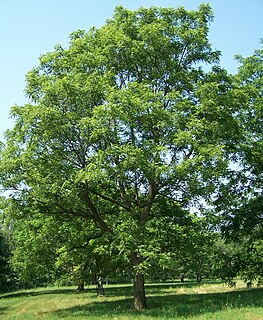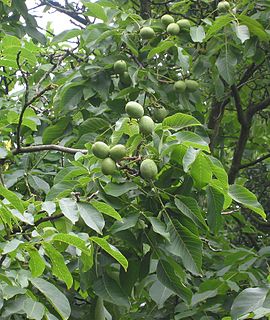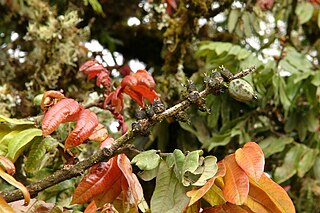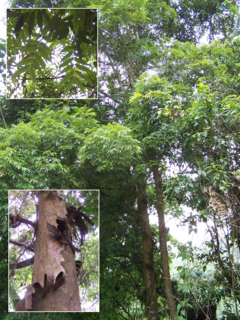
Walnut trees are any species of tree in the plant genus Juglans, the type genus of the family Juglandaceae, the seeds of which are referred to as walnuts. All species are deciduous trees, 10–40 metres (33–131 ft) tall, with pinnate leaves 200–900 millimetres (7.9–35.4 in), with 5–25 leaflets; the shoots have chambered pith, a character shared with the wingnuts (Pterocarya), but not the hickories (Carya) in the same family.

The Juglandaceae are a plant family known as the walnut family. They are trees, or sometimes shrubs, in the order Fagales. Members of this family are native to the Americas, Eurasia, and Southeast Asia.

Hickory is a type of tree, comprising the genus Carya, which includes around 18 species. Five or six species are native to China, Indochina, and India (Assam), as many as twelve are native to the United States, four are found in Mexico, and two to four are from Canada. A number of hickory species are used for products like edible nuts or wood.
Rhoiptelea is a monotypic genus of flowering plants in the family Juglandaceae. It contains a single species, Rhoiptelea chiliantha, commonly known as the horsetail tree. This genus was previously recognized in its own family, Rhoipteleaceae, but the APG III system of 2009 placed it in the Juglandaceae family. Rhoiptelea chiliantha is native to southwest China and north Vietnam and lives at the elevation of 700-1600m in mountainous areas. The trees are wind-pollinated, the flowers arranged in large sagged panicles usually 32 cm long like horse tails, and the fruit is a small botanical nut with rounded wings. The leaves are pinnately compound and papery. The trees are usually 17 m high and with 40 cm diameter. It is a protected species of China.
Ulmus laevis var. celtideaRogow. is a putative variety of European White Elm first described by Rogowicz, who found the tree in 1856 along the river Dnjepr near Chernihiv in what is now northern Ukraine. The type specimen is held at the National Herbarium of Ukraine. The variety was first named as Ulmus pedunculata var. celtidea. Litvinov (1908) considered it a species, calling it Ulmus celtideaLitv., a view not upheld by other authorities.

Ulmus mexicana(Liebm.) Planch., the Mexican elm, is a large tree endemic to Mexico and Central America. It is most commonly found in cloud forest and the higher elevations (800–2200 m) of tropical rain forest with precipitation levels of 2–4 m per year, ranging from San Luis Potosi south to Chiapas in Mexico, and from Guatemala to Panama beyond. The tree was first described botanically in 1873.

Alfaroa is a genus of evergreen trees in the Juglandaceae family of the Fagales, growing in montaine and submontaine tropical rain forests in Central America. The wood is characterized by solid pith, pink heartwood, and vessels with scalariform perforations, as well as simple perforations.

Alfaroa mexicana is a species of plant in the family Juglandaceae. It is endemic to Mexico.
Juglans jamaicensis, the West Indian walnut, nogal, or palo de nuez, is a species of walnut in the Juglandaceae family. It is found in Cuba, the Dominican Republic, Haiti, and Puerto Rico. It is not, in fact, native to Jamaica, as its name would suggest.

Oreomunnea pterocarpa, known locally as gavilán or gavilán blanco, is a species of Oreomunnea in the family Juglandaceae. It is found in Costa Rica, southeastern Mexico (Chiapas), and Panama.

Pterocarya fraxinifolia is a species of tree in the Juglandaceae family. It is commonly known as the Caucasian wingnut or Caucasian walnut. It is native to the Caucasian region Armenia, Azerbaijan, Georgia, Iran, Russia, Ukraine and Turkey. It was introduced to France in 1784, and to Great Britain after 1800.

Macropidia fuliginosa, the sole species of genus Macropidia, is a perennial rhizomatous flowering plant. Commonly known as the black kangaroo paw, it is endemic to Southwest Australia, specifically from Perth to Geraldton in the north of the region.

Prunus mexicana, commonly known as the Mexican plum, is a North American species of plum tree that can be found in the central United States and Northern Mexico. Its native range stretches from Coahuila and San Luis Potosí north as far as Wisconsin and South Dakota, east to Georgia, Kentucky, and Ohio. Mexican plum is widely cultivated, such as on the west coast of the United States.

Alfaroa costaricensis, also known as campano chile, chiciscua, gaulin, gavilán Colorado, or gavilancillo, is nut bearing timber tree in the Juglandaceae family. It is native to the Neotropics, from Mexico, through Central America to Colombia.

Oreomunnea mexicana is a species of plant in the family Juglandaceae, which grows in the tropical rain forests of Mexico, Guatemala, Nicaragua, Costa Rica, and Panama at altitudes from 1–1.7 km. Common names include guayabo amarillo and remiendo. The chromosome number is 2n = 32.
Alfaroa manningii, or gavilán colorado, is a valued lumber tree of the Walnut family endemic to the premontane Costa Rican rain forest. The specific epithet honors the American botanist Wayne Eyer Manning (1899–2004).
Carya washingtonensis is an extinct species of hickory nut in the walnut family Juglandaceae. The species is solely known from the Miocene sediments exposed in Kittitas County near Ellensburg, Washington.
Hymenaea mexicana is an extinct legume species in the family Fabaceae described from a series of isolated fossil petals, leaflets, and amber. The species is known from a group of Late Oligocene to Early Miocene locations in southern Mexico. It is one of two extinct Hymenaea species placed close to the living species Hymenaea verrucosa and along with Hymenaea allendis, is one of the two extinct species which have been found in Mexican amber.

Eremophila pterocarpa, commonly known as silver poverty bush or winged-fruited eremophila, is a plant in the figwort family, Scrophulariaceae and is endemic to Western Australia. It is a densely foliaged, upright shrub with most of its parts covered with a silvery powder.

Tilia carolinianaMill. is a species of tree in the family Malvaceae native to the southern and south-eastern states of the U.S., and Mexico.













